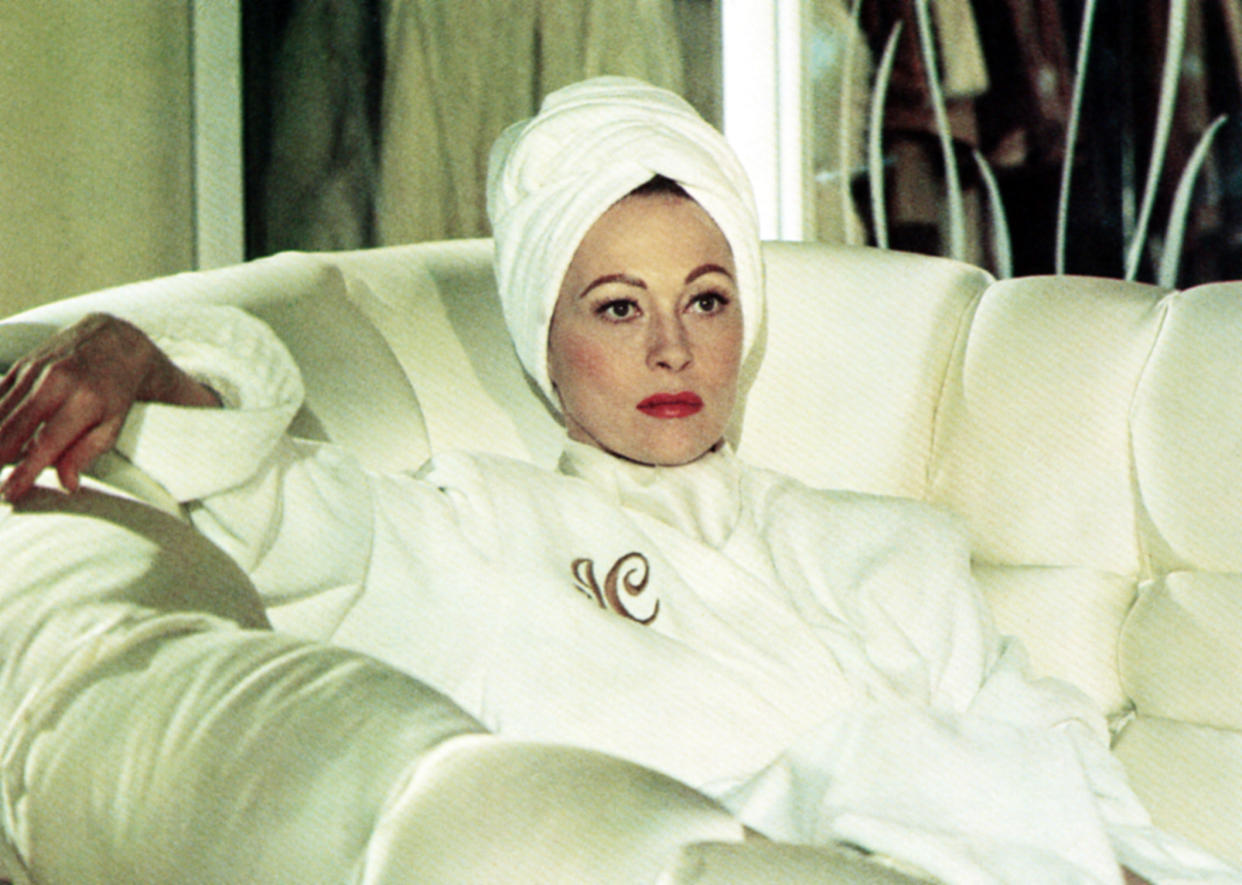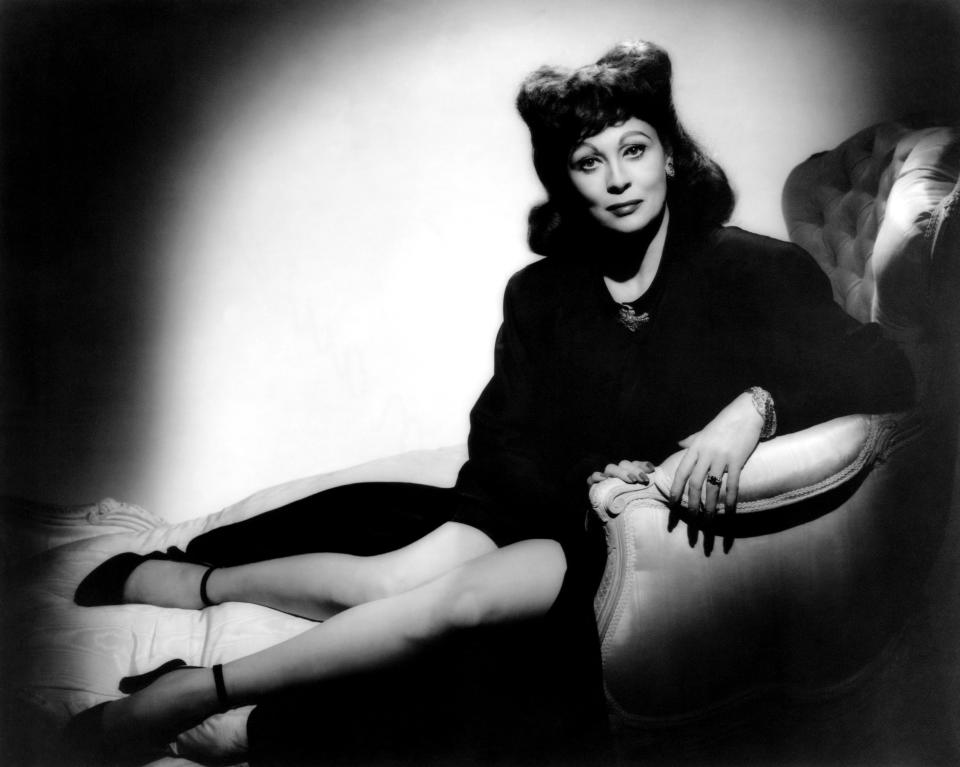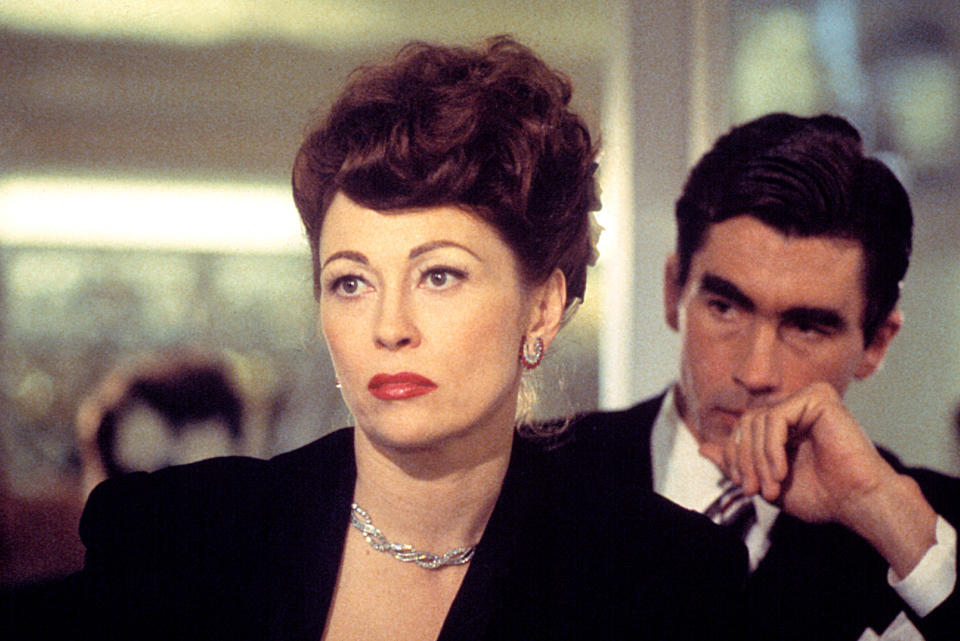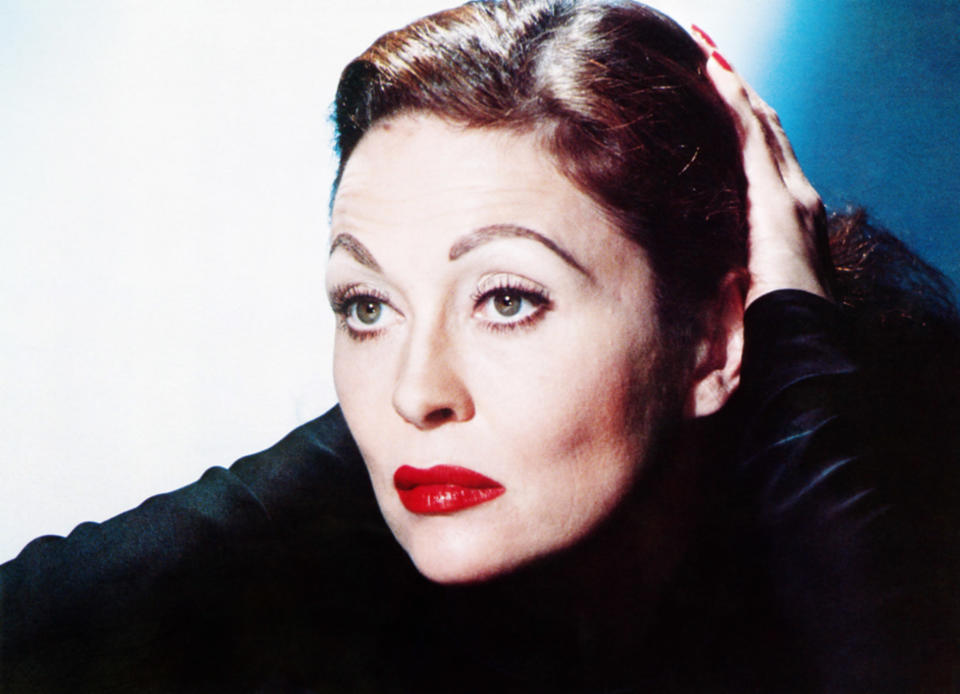How ‘Mommie Dearest’ Transformed Faye Dunaway Into Joan Crawford

- Oops!Something went wrong.Please try again later.
- Oops!Something went wrong.Please try again later.
- Oops!Something went wrong.Please try again later.
- Oops!Something went wrong.Please try again later.
- Oops!Something went wrong.Please try again later.
Mother’s Day means a lot of things — and for many, it means a chance to grab some wire hangers and rekindle a love for the 1981 camp extravaganza “Mommie Dearest.” Starring Oscar winner Faye Dunaway as Oscar winner Joan Crawford, the movie adaptation of a memory by Crawford’s adopted daughter, Christina, was intended to be a serious drama. An awards-bait biopic. Anne Bancroft was attached, initially!
But things went awry, as they always do in the making of a camp classic. And while we wait for Dunaway to address the movie anew in the upcoming “Faye” documentary about her life and career premiering at Cannes, we have A. Ashley Hoff’s making-of book “With Love, Mommie Dearest: The Making of an Unintentional Camp Classic” to tide us over.
More from IndieWire
One of the most remarkable things Hoff uncovered in his voluminous research is just how enthralled everyone was by Dunaway’s resemblance to Crawford — and the extreme care (and cost) expended on making her feel every inch the Golden Age movie star. In this excerpt, Hoff details the many lengths the production team went to in order to bring Crawford back to life … even as the film threatened to bury Dunaway’s career.
“With Love, Mommie Dearest: The Making of an Unintentional Camp Classic” is available now.

Excerpted from “With Love, Mommie Dearest: The Making of an Unintentional Camp Classic.” Used with the permission of the publisher, Chicago Review Press. Copyright © 2024 by A. Ashley Hoff.
[Producer] Frank Yablans did not confine [costume designer Irene] Sharaff to a budget for the costumes. She told the press, “I had the clothes made in London because there are no women’s tailors in Hollywood now — they have either died out or retired. Also, it is easier to get fabrics over there because of the proximity to Paris.
“The material was very important and it can’t be found in the United States today,” she stressed. For the suit Faye wears while distributing gifts at the orphanage, Sharaff selected a rare English antelope fabric unavailable in the United States. The bronze-toned hat was made of soele felt, and the Cartier double-clip pin was loaned by Frances Klein Estate Jewels. Because Joan Crawford was largely remembered in black-and-white movies, most of the clothes were in a subtle color palette.
All the suits had to be well tailored to suit the character. Three dresses in the film were embroidered by Stanley Locke, who did the embroidery on Queen Elizabeth’s dresses. (Sharaff’s personal favorite was seen in the rosebushes scene.)
Nevertheless, Irene Sharaff and Faye Dunaway were at odds. While Irene worked at MGM under Adrian and knew him, Faye had been wearing Adrian’s original designs for years, fifty or sixty of his outfits throughout her career. She was as familiar with his designs and workmanship as Irene was.
The finished costumes arrived at Paramount in boxes sent from Bermans & Nathans in London and were unpacked. But they had been tailored for Anne Bancroft, so had to be reworked to properly fit Dunaway. (This may be especially noticeable in the cut of the fifties-styled costumes Faye wears in the scenes during her confrontation with Mrs. Chadwick at the school and during her fight scene with Diana Scarwid.)
And the shoulder pads were all wrong. Despite the British excelling in both the quality of their embroidery and the fabrics they used, somehow crafting shoulder pads had eluded them. When the forties-styled costumes were unpacked, Faye demanded the shoulder pads be removed and redone; she knew enough about Adrian’s cuts and the lines of his clothes to know the British mock-ups were the wrong size and sewn in at the wrong angles.
This created additional work for Irene and her assistants. Faye’s dresser Bernadene Mann, a gifted seamstress, was pressed into service to help rework costumes, which didn’t endear either to the formidable Ms. Sharaff or her staff.
They resented Faye and, by extension, Bernadene, who apparently felt like she had to pick sides. But who was she going to side with, a woman who already resented her or the woman who continued to hire her, bringing her on board every film and television project she worked on? It was a no-brainer. But picking Faye, Bernadene suspected, got her in hot water with other cast and crew members, who seemed to view theirs as an enemy camp.
The other problem with the costumes was that there was only one of each outfit. If, say, makeup or food stained a costume, there was no way to set it aside and grab a backup costume, so everything had to be handled with meticulous care.

The tension got to be so bad that Mann went to Frank Yablans and told him she might have to quit. He pleaded with her to stay, asked what he could do to make her job easier, and ultimately commandeered Edith Head’s former office on the second floor in one of Paramount’s buildings. He gave Mann the keys and said it was her sole and exclusive domain so that she could work in peace.
Faye’s hairstyles had to work with the outfits she wore. “Faye’s hair is shoulder length,” her hairdresser, Kathryn Blondell, said at the time. “But we are using hair pieces or full wigs on her in practically every scene. Not only because Crawford wore hairpieces most of the time, but also because we need that extra volume to make Faye’s head resemble Crawford’s.”
Vivienne Walker designed the fifteen wigs Faye wore, which were executed by Josephine Turner, renowned as the grande dame of Hollywood wigmakers. Walker often worked with Joan Crawford in the fifties and sixties and said, “Faye worked with me for two solid weeks planning the wigs, she has every book about Crawford, plus thousands of portraits. I brought Faye samples of hair; we would blend them to get them right.” Black-and-white films give the impression Crawford was a brunette, but she actually dyed her hair red or auburn (and at least once even tried blonde).
The jewels worn in the film were selected from the collection of Frances Klein Estate Jewels, then located at 310 North Rodeo Drive in Beverly Hills. Everyone from Cary Grant to Frank Sinatra to Laurence Olivier shopped there, and the jeweler was one of the prime sources for loaning jewelry to the nominees at awards season to wear to events like the Oscars. Frank Yablans asked Klein to collaborate on the film. Using preliminary sketches of the gowns, Sharaff, Klein, and Dunaway selected the jewelry to be worn in each scene—pieces by Cartier, Tiffany, Bucellati, and Chaumet—from the store’s collection. When the movie was being filmed, the studio dispatched an armed guard to the store to pick up the pieces needed for each day’s work.
Unfortunately, sometimes even an armed guard can’t protect the jewels . . .
As she already proved the day Frank Yablans opened his front door to find her there, Faye Dunaway could look astonishingly like Crawford when made up for it. And to their eternal credit, it was all thanks to Dunaway’s partnership with Lee Harman.
Harman grew up in Los Angeles, was active in sports, even played professional basketball briefly (until he “ran out of gas,” he said), and ended up in the makeup department. The hairstylist for Chinatown recommended him to Dunaway, and they worked on many films together (proving that despite her reputation, there were definitely some crew members who worked well and did repeat business with Faye Dunaway).
“Lee Harman. God, he was cool,” remembered Jonathan Zimbert, Frank Yablans’s assistant. “The thing that endeared him to the actresses he worked with was his discretion. His loyalty was to the performer. Everyone loved this guy, so he could just wander the set and eyeball the lighting and if there’s something that he knows is going to bother Faye, it could be corrected, and it’s not confrontational.”
Lee always remained loyal to Faye but knew she had her share of personal demons. When he left her for two weeks during filming of The Champ (in which she costarred with Jon Voight and Ricky Schroeder) then returned, she had gained twenty pounds. She was depressed and just sat in her motel room eating Monte Cristo sandwiches.
So Lee and his son David became her trainers, accompanying her up into one of the national forests in the mountains outside Los Angeles to burn calories on the trails. The gaining and losing of weight being a stressful activity to begin with, it is even more stressful for an actress whose career is dependent on her looks. At one point, according to David Harman, Faye kind of lost it and began swearing at him. Lee went ballistic, got in her face, and told her in no uncertain terms, “If you ever speak to my kids like that again you’ll be walking back to L.A.”
“Faye has an unusual face. You can do almost anything with it and it will come out okay,” said Lee Harman. “She is very demanding, a perfectionist. She really gets into the makeup and wants to have a say in what you do. It’s good, though, because it brings out the best in you. You really work together with her. And she thinks I’m special or something and lets me use what I want.”

Harman worked in a loose shirt with at least two pockets to stash his Q-tips, brushes, and powder, always working with the wooden end of a Q-tip between his teeth. “It’s my eraser,” he admitted. “I make lots of mistakes.”
He admitted Mommie Dearest was their most difficult project. “Faye demands the best job you can do, but works just as hard herself. She has thousands of stills of Crawford, and she and I watched Crawford’s movies together so we could see how the makeup progressed over the years.”
After watching those movies, they realized Joan’s brows gradually got thicker and wider through the years. While every other actress was tweezing her brows in the thirties, Crawford let hers grow back before experimenting with different shapes and thicknesses. Her brows remained black despite the color she dyed her hair.
To recreate the Crawford look—high arched and heavy eyebrows and a strong lip line—Dunaway plucked out her own eyebrows. The false ones raised the line of her screen eyebrows a quarter of an inch, and the oversized lip line was drawn in with dark, heavy makeup. Crawford herself painted over the outer edges of her upper lips to convey the personality of Sadie Thompson in Rain (1932). Audiences were shocked, and the style was condemned. But soon enough, the term “the overlip” was coined, with millions of women copying the fad into the fifties.
Crawford built up and wore a large collection of false curls, falls, and bumper bangs designed by MGM hairstylist Sydney Guilaroff because her fine-textured natural hair lacked volume. Dunaway’s own hair was seen only in the early scenes. She wore twelve different wigs in the movie, which came in three shades of red, from a dark reddish-brown to a lighter, natural red. One of Crawford’s old falls was actually unearthed and used by Dunaway in the movie. All were constantly cleaned and blocked by two assistant hairdressers.
An adhesive material stretched over Faye’s skin gave her an older appearance. The makeup was applied directly over the mask, and over that a harder, thicker base. When Faye went in the pool or shower, her false brows were covered with hair spray and her lipstick with a sealer.
As a result, those who remembered Joan Crawford in her MGM pictures were surprised to see how much Faye resembled the late star.
The day they shot the screen test was a nightmare. Faye wasn’t ready, even by noon. It took Lee Harman over nine hours (“without eating,” he specified) to get the makeup right. “It was the longest I had ever worked on anything,” he admitted. “We would measure a picture of Joan Crawford with Q-tips to get the eyebrows and the distance between the eyes exact,” he said.
The pressure was relentless. Lee wanted to quit the film several times. “The perfection of it was so difficult,” he admitted, “the most difficult thing I ever worked on. It was Hollywood inside Hollywood. People knew what Crawford looked like, so everyone was zeroing in to see what you were doing . . . but Faye told me I couldn’t leave. ‘You got me into this,’ she kept telling me.
“Faye used a magnifying glass,” he remembered. “She always uses a magnifying glass, and I always try to hide it from her. Now it’s my first rule—never let an actress or actor look through a magnifying glass…”
Together, the pair got the makeup just about right, but something was still missing. “It was about muscles,” Faye later explained to James Lipton on Inside the Actor’s Studio. “My makeup man and I sat in that trailer for quite a long time. . . . I kept staring at the picture and I finally realized: it was the way she held her face . . . how she trained the muscles to be in that star kind of mask, really, is what it was. And that was the discovery.” (Of course, it wasn’t all facial muscles. “She had a lot of make-up on, believe me!” laughed Rutanya Alda.)
Ready, at last, Faye exited the trailer. A hush fell on the set. Those who had worked with Joan Crawford were riveted. It was as if a ghost materialized on set.
Excerpted from “With Love, Mommie Dearest: The Making of an Unintentional Camp Classic.” Used with the permission of the publisher, Chicago Review Press. Copyright © 2024 by A. Ashley Hoff.
Best of IndieWire
The 13 Best Thrillers Streaming on Netflix in May, from 'Fair Play' to 'Emily the Criminal'
The Best Father and Son Films: 'The Tree of Life,' 'The Lion King,' and More
The 10 Best Teen Rebellion Films: 'Pump Up the Volume,' 'Heathers,' and More
Sign up for Indiewire's Newsletter. For the latest news, follow us on Facebook, Twitter, and Instagram.

